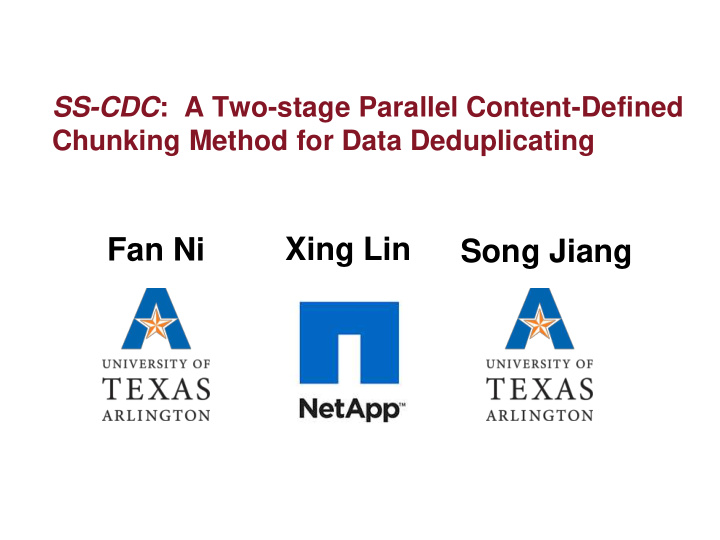



SS-CDC : A Two-stage Parallel Content-Defined Chunking Method for Data Deduplicating Fan Ni Xing Lin Song Jiang Cluster and Internet Computing Laboratory Wayne State University
Data is Growing Rapidly From storagenewsletter.com ▪ Most of the data needs to be safely stored. ▪ Efficient data storage and management have become a big challenge. 2
The Opportunity: Data Duplication is Common ▪ Sources of duplicate data: – The same files are stored by multiple users into the cloud. – Continuously updating of files to generate multiple versions. – Use of checkpointing and repeated data archiving. ▪ Significant data duplication has been observed. – For backup storage workloads • Over 90% are duplicate data. – For primary storage workloads • About 50% are duplicate data. 3
The Deduplication Technique can Help Then only one copy is stored: When duplication is detected File1 (using fingerprinting): Logical Physical SHA HA1( 1( ) ) = S = SHA HA2( 2( ) ) File1 File2 File2 ▪ Benefits – Storage space – I/O bandwidth – Network traffic ▪ A important feature in commercial storage systems – NetApp ONTAP system – Dell-EMC Data Domain system ▪ The data deduplication technique is critical. – How to deduplicate more data? – How to deduplicate faster? 4
Deduplicate at Smaller Chunks … Remove Chunking and duplicate chunks fingerprinting … for higher deduplication ratio ▪ Two potentially major sources of cost in the deduplication: – Chunking – Fingerprinting ▪ Can chunking be very fast?
Fixed-Size Chunking (FSC) ▪ FSC: partition files (or data streams) into equal- and fixed-size chunks. – Very fast! ▪ But the dedup ratio can be significantly compromised. – The boundary-shift problem. HOWAREYOU?OK?REALLY?YES?NO File A File B HOWAREYOU?OK?REALLY?YES?NO 6
Fixed-Size Chunking (FSC) ▪ FSC: partition files (or data streams) into equal- and fixed-size chunks. – Very fast! ▪ But the dedup ratio can be significantly compromised. – The boundary-shift problem. File A HOWAREYOU?OK?REALLY?YES?NO H File B HOWAREYOU?OK?REALLY?YES?NO 7
Content-Defined Chunking ( CDC) ▪ CDC: determines chunk boundaries according to contents (a predefined special marker). – Variable chunk size. – Addresses boundary-shift problem – However, it can be very expensive Assume the special marker is ‘ ? ’ HOWAREYOU?OK?REALLY?YES?NO File A File B H HOWAREYOU?OK?REALLY?YES?NO Actually the marker is determined by applying a hash function on a window of bytes, such as hash(“YOU?”) == pre -defined-value ➔ Even more expensive (likely more than half of the dedup cost!) 8
Parallelizing CDC Chunking Operations A File 9
Parallelizing CDC Chunking Operations A File Parallelize its chunking: p 0 p 1 p 2 p 3 10
Parallelizing CDC Chunking Operations A File Parallelize its chunking: p 0 p 1 p 2 p 3 However, the parallelized chunking can compromise deduplication ratio. 11
Compromised Deduplication Ratio Higher is better Deduplication ratio = data size before dedup / data size after dedup 12
Chunks can be Different! The rule of forming chunks: – Usually between two adjacent markers. – But neither too small (≥ Minimum-chunk-size) nor ( ≤ maximum-chunk-size) – Inherently a sequential process min max The parallel chunking: – Artificially introduce a set of markers (segment boundaries). – These maker positions change with data insertion/deletion. • 13 – Partially brings back the boundary shift problem.
The Goal of this Research To design a parallel chunking technique that … – Does not compromise any deduplication ratio. – Achieves superlinear speedup of chunking operations. 14
Approach of the Proposed SS-CDC Chunking Two-phase chunking: – Stage 1: produce all markers in parallel on a segmented file • A thread works on 16 consecutive segments at a time. • Use AVX-512 SIMD instructions to process the 16 segments in parallel at a core. File One thread • The markers are recorded in a bit vector 15
The Approach of the Proposed SS-CDC Chunking Two-phase chunking: – Stage 2: sequentially determines the chunks based on the marker bit vector • Take account of minimum and maximum chunk sizes 16
Advantages of SS-CDC ▪ It doesn’t have any loss of deduplication ratio – The second stage is sequential. – It generates the set of chunks exactly the same the sequential chunking. ▪ It potentially achieves superlinear speedup. – Stage 1 accounts for about 98% of the chunking time. – Stage 1 is parallelized across and within cores. – With optimization, Stage 2 accounts for less than 2% of the chunking time. 17
Experiment Setup ▪ The hardware – Dell-EMC PowerEdge T440 server with 2 Intel Xeon 3.6GHz CPUs – Each CPU has 4 cores and 16MB LLC. – 256GB DDR4 memory. ▪ The Software – Ubuntu 18.04 OS. – The rolling window function is Rabin. – Minimum/average/maximum chunk sizes are 2KB/16KB/64KB, respectively. 18
The Datasets Name Description Cassandra Docker images of Apache Cassandra, an open-source storage system Redis Docker images of the Redis key-value store database Debian Docker images of Debian Linux distribution (since Ver. 7.11) Linux-src Uncompressed Linux source code (v3.0 ~ v4.9) downloaded from the website of Linux Kernel Archives Neo4j Docker images of neo4j graph database Wordpress Docker images of WordPress rich content management system Nodejs Docker images of JavaScript-based runtime environment packages 19
Single-thread/core Chunking Throughput Consistently about 3.3X speedup 20
Multi-thread/core Chunking Throughput The chunking speedups are superlinear and scale well. • 21
Existing Parallel CDC Deduplication Ratio Reduction 50 512KB segments Dedup Ratio Reduction (%) 1MB segments 40 2MB segments 30 20 10 0 Cassandra Redis Debian Linux-src Neo4j Wordpress Node Datasets ▪ Compared to SS-CDC, the reduction can be up to 43%. ▪ Using smaller segments leads to higher reduction
Conclusions ▪ SS-CDC is a parallel CDC technique that has – high chunking speed. – zero deduplication ratio loss. ▪ SS-CDC is optimized for the SIMD platforms. – Similar two-stage chunking techniques can be applied in other platforms such as GPU. 23
Recommend
More recommend